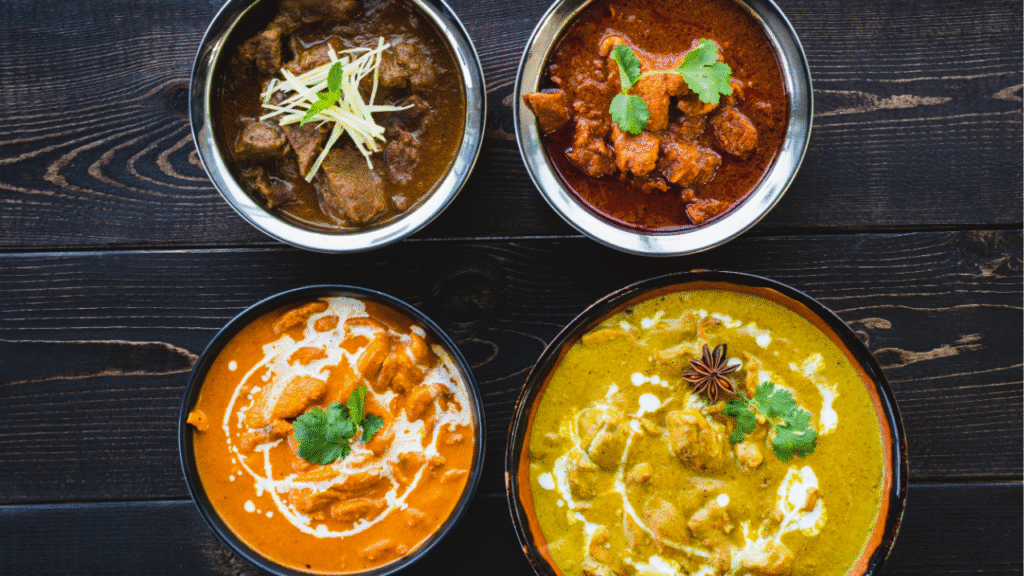When someone asks, “What is Indian food?”, the first word that often comes to mind is “curry.” But is Indian cuisine really just about curry? The truth is far more diverse, flavorful, and complex than that.
This blog explores what Indian food truly is—beyond the curry stereotype—and reveals the rich culinary traditions that span across India.
Curry Is a Concept, Not a Dish
Let’s clarify a common misconception: there is no specific dish called ‘curry’ in traditional Indian cuisine.
The term “curry” was introduced by the British as a generic label for the many saucy Indian dishes they encountered. In reality, Indian cuisine uses precise terms for such dishes, including:
- Sabzi (vegetable dishes)
- Korma (creamy stews)
- Saag (leafy greens-based)
- Dal (lentil-based preparations)
- Jhol, Salan, Kuzhambu, Theeyal, Gassi, and others depending on the region
Each has its unique ingredients, spices, and cooking techniques. Grouping them all under “curry” oversimplifies and misrepresents their diversity.
Check Out: Spicy Indian Food Health Secrets: Surprising Benefits for Mind and Body
A Cuisine as Diverse as Its People
India is a land of 28 states and countless communities, each with its distinct culinary traditions. Indian food varies significantly from one region to another.
North Indian Specialties
- Tandoori Dishes: Grilled meats and breads made in clay ovens
- Chole Bhature: Spiced chickpeas served with fried bread
- Parathas: Stuffed flatbreads accompanied by yogurt and chutneys
South Indian Staples
- Dosa and Idli: Fermented rice-lentil crepes and cakes, typically served with sambar and coconut chutney
- Rasam: A tangy, peppery broth
Western and Eastern Indian Highlights
- Thepla and Undhiyu from Gujarat
- Machher Jhol (fish stew) from Bengal
- Litti Chokha from Bihar
- Goan Prawn Balchão (vinegar-based prawn pickle)
None of these dishes are “curries” as commonly understood, yet all are integral to Indian cuisine.
The Role of Spices
Indian food is known not just for its heat but for its deep and layered use of spices. Spice blends such as:
- Garam Masala
- Panch Phoron
- Sambar Powder
- Chaat Masala
These are crafted to add complexity, aroma, and depth to a dish—not just spiciness.
Indian Food Is Also
- Dry: Aloo fry, bhindi sabzi
- Fermented: Dosa batter, dhokla
- Steamed: Idlis, modaks
- Fried: Samosas, pakoras, pooris
- Sweet: Gulab jamun, jalebi, rasgulla
These styles showcase how Indian food spans a full spectrum beyond the curry concept.
Check Out: Vegetarian Indian Food Recipes: 2 Healthy & Delicious Meals in Under 30 Minutes
Busting the Myths
Myth 1: All Indian food is curry-based
Reality: Indian cuisine includes grilled, dry, fried, steamed, and sweet dishes.
Myth 2: Indian food is too spicy
Reality: Spice levels are adjustable, and many dishes are mild or sweet.
Myth 3: Indian food is the same everywhere
Reality: Food varies greatly by region, religion, and tradition.
Conclusion: What Is Indian Food Without Curry?
Indian food without “curry” is still richly Indian. In fact, moving beyond that term helps us see the cuisine’s true essence:
- Regional integrity
- Balanced spice blends
- Seasonal and local ingredients
- Deep-rooted tradition
The next time you think about Indian food, consider saying chole, rasam, thepla, or dal makhani instead of just “curry.” That’s the real taste of India—complex, comforting, and endlessly diverse.
Discover More
Visit Indian.Community to explore more about Indian cuisine, local Indian restaurants, and authentic food experiences near you.
